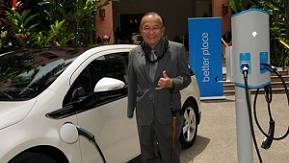On EV Charging Points
Posted on 27/Apr/2011
 EV Technologies are galloping faster than EV infrastructure.They have to move in tandem if the EV revolution is to happen sooner than later.However, some countries are giving EV infrastructure development the importance it deserves hoping,thereby, to add speed to the EV cause in general.
EV Technologies are galloping faster than EV infrastructure.They have to move in tandem if the EV revolution is to happen sooner than later.However, some countries are giving EV infrastructure development the importance it deserves hoping,thereby, to add speed to the EV cause in general. User Comments
i want to perch-ace your product but i don't know any price in indian rupees
The sustainable electrification of individual transport requires standards in charging infrastructure and vehicles. In addition to standard components, charging stations also have operator-specific characteristics, which can depend on the perator's location or business model.
Phoenix Contact has a product and technology range with which different charging infrastructure concepts can be implemented in a flexible, modular and efficient way.
Integration in the IT world
Integration into the operator's
IT infrastructure is implemented by the
Phoenix Contact controllers' direct
communication with the database
management systems using SQL or SNMP
without any additional middleware.
Connecting to an energy management
system for peak load reduction as well as
an ERP system (Enterprise Resource
Planning) for billing energy costs is possible
without any problems.
The most important requirement for setting up a modern
charging infrastructure is a reliable and universal connection
for charging stations and sockets.
The electrical energy must be supplied externally in the
form of direct current (DC) or alternating current (AC)
for recharging the batteries. If AC is used for charging,
the energy can be supplied directly from the existing low
voltage network to the integrated AC/DC converter in the
vehicle.
In the case of DC charging, the AC/DC converter is
located within the charging station and reduces the load
on the vehicle. Shorter downtimes during breaks in longer
distances are normal in this case.
The COMBO concept integrates both the AC and DC
process and therefore constitutes the ideal charging
interface for future-oriented electromobility.
Phoenix Contact has a product and technology range with which different charging infrastructure concepts can be implemented in a flexible, modular and efficient way.
Integration in the IT world
Integration into the operator's
IT infrastructure is implemented by the
Phoenix Contact controllers' direct
communication with the database
management systems using SQL or SNMP
without any additional middleware.
Connecting to an energy management
system for peak load reduction as well as
an ERP system (Enterprise Resource
Planning) for billing energy costs is possible
without any problems.
The most important requirement for setting up a modern
charging infrastructure is a reliable and universal connection
for charging stations and sockets.
The electrical energy must be supplied externally in the
form of direct current (DC) or alternating current (AC)
for recharging the batteries. If AC is used for charging,
the energy can be supplied directly from the existing low
voltage network to the integrated AC/DC converter in the
vehicle.
In the case of DC charging, the AC/DC converter is
located within the charging station and reduces the load
on the vehicle. Shorter downtimes during breaks in longer
distances are normal in this case.
The COMBO concept integrates both the AC and DC
process and therefore constitutes the ideal charging
interface for future-oriented electromobility.

